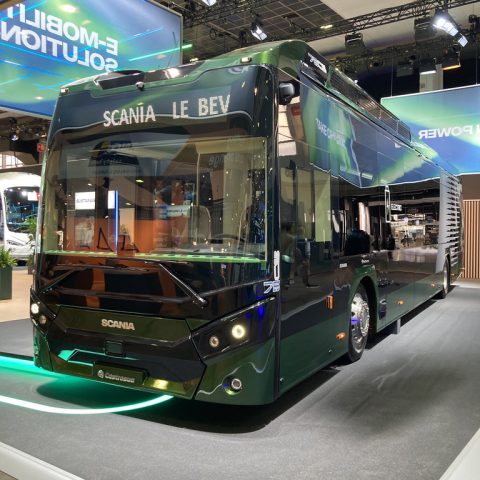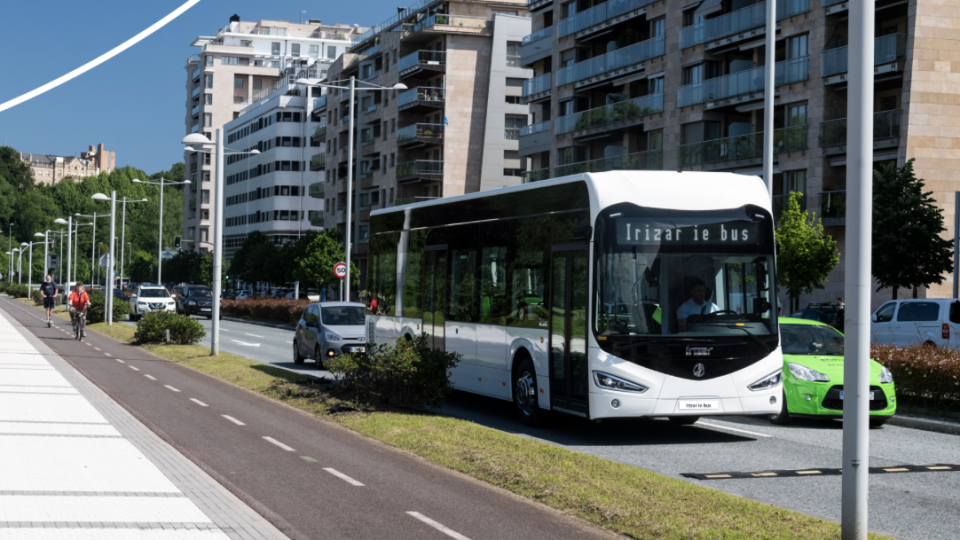Scania unveiled its new battery-electric bus platform in Busworld
The new Scania battery-electric bus platform made its debut at Busworld on 6th October. With the introduction of low-entry 4×2 buses, the batteries offer energy storage capacity of up to 520 kWh and have been developed specifically for heavy commercial vehicles, enabling a range in optimal conditions of over 500 km, manufacturer states. The initial […]

The new Scania battery-electric bus platform made its debut at Busworld on 6th October. With the introduction of low-entry 4×2 buses, the batteries offer energy storage capacity of up to 520 kWh and have been developed specifically for heavy commercial vehicles, enabling a range in optimal conditions of over 500 km, manufacturer states.
The initial introduction of the new platform is made available in low-entry 4×2 buses which will be developed in close collaboration with bodybuilder partners. The one showcased in Brussels is done with Castrosua.
Scania Low Entry intercity bus platform
These buses will be available in two performance steps – a four-battery variant with an installed capacity of 416 kWh and a five-battery variant with an installed capacity of 520 kWh. In optimal conditions, this equates to a range of more than 400 km for the former, and over 500 km for the latter.
“During the development of our new battery electric bus platform, range, performance, and battery responsibility have been key areas – all crucial to achieving viable and sustainable transport systems. Combined with our latest e-mobility services and solutions, this means we will provide complete and highly competitive solutions for urban applications in all our current regions,” says Carl-Johan Lööf, Head of Product Management, People Transport Solutions at Scania.
New Low Entry e-bus from Scania coming
The low-entry 4×2 BEV is suitable for medium and heavy-duty operations, in city, suburban, and regional applications, in both Class I and Class II. The bus comes in two different chassis widths – 2500 mm and 2550 mm – and the two different axle gears provide ratio options that work in the most challenging topography. The new electric machine (it’s unclear if it’s the one developed within Traton group or a product by Scania or external partner) “is more powerful as it comes with a newly integrated cooling system and an updated control system which meets the highest cyber security demands. The machine runs at 300 kW in peak operation and 250 kW in continuous operation”, Scania says.
High-capacity battery packs in both 4-pack (416 kWh) and 5-pack (520 kWh) configurations equate to a range of more than 400 km and 500 km respectively, in optimal conditions. The batteries have been developed and are built in partnership with Northvolt.
Multiple advanced state-of-the-art driver assistance systems (ADAS), additional safety features, and strong protection from cyber security threats provide the safest possible operation for the driver, the passengers and surrounding road users. These meet and even exceed the strict EU safety regulations for heavy commercial vehicles.
Powered by the new electrical system and Smart Dash instrument panel, the buses come with new or improved digital functionalities – from safety functions and remote diagnostics to real-time maps and over-the-air capabilities. The future-proof Smart Dash is the ultimate interface that provides wireless updates, and full integration to other digital touchpoints. It enhances the driver experience and makes it more intuitive, while also increasing operational efficiency.
“Today 90 percent of the emissions in cities comes from out of the inner urban centers. For the long distance segment, Scania Group is showcasing a LNG-powered coach, built in cooperation with Irizar, able to run for 1,200 km on a single refill. Going to suburban areas, I’m happy to introduce Scania new battery electric bus platform, with battery capacity of 520 kWh. It’s at our stand as a intercity LE bus built in cooperation with Grupo Castrosua, one of our partners” said Johanna Salomonsson Lind, Senior Vice President Head of People Transport Solutions, Scania, during the opening ceremony of Busworld Europe on 5th October.







